She writes stories and situations and draws characters too and I build up a scientific fictional background and sometimes do fan service
Pratically I offer scientific consultation *lol*
Anyway her gallery is viewable here:
http://gorgonbreath.deviantart.com/
Now Celestia-related discussion. Because I am working on a possible add-on to propose, though I'm finding some troubles to get alternate Solar System as default.
Dystopia is the name of the fiction.
It takes place on an alternate Earth, and alternate Solar System. Apparently nothing differs from our Universe, even life has developed in specular way as in our Universe and so have Mankind and its History.
Everything alike our World
...but here difference is...
In Dystopia Universe star's life lasts half than expected time calculated in our Universe. If a Sun-like star, with 1 solar mass, takes 10 billion years before dying in Our Universe, in Dystopia's one takes only 5. And Sun is just 5 billion years old.
In Dystopia Universe star's life lasts half than expected time calculated in our Universe. If a Sun-like star, with 1 solar mass, takes 10 billion years before dying in Our Universe, in Dystopia's one takes only 5. And Sun is just 5 billion years old.
So the lifetime formula:
TMS= 10[sup]10[/sup][M/M][sub]Sun[/sub]][L[sub]Sun[/sub]/L]
Has to be divided by two.
So in Dystopia's Universe the Sun is close to death.
And so are other evolved stars in Solar Neighborhood
Especially the brightest ones alike Sirius and Procyon
[big]How does Dystopia Universe appears?[/big]
The Sun has nearly exhausted hydrogen and is slowly beginning burning helium in its core. Mankind's technology has allowed to terraform and settle Mars and to emigrate towards younger Solar System analogues too. Indeed Earth's inhabitant have gone elsewhere, alike Epsilon Eridani, Epsilon Indi, Sigma Draconis et cetera, where other "blue dots" are present and can host newborn colonies.
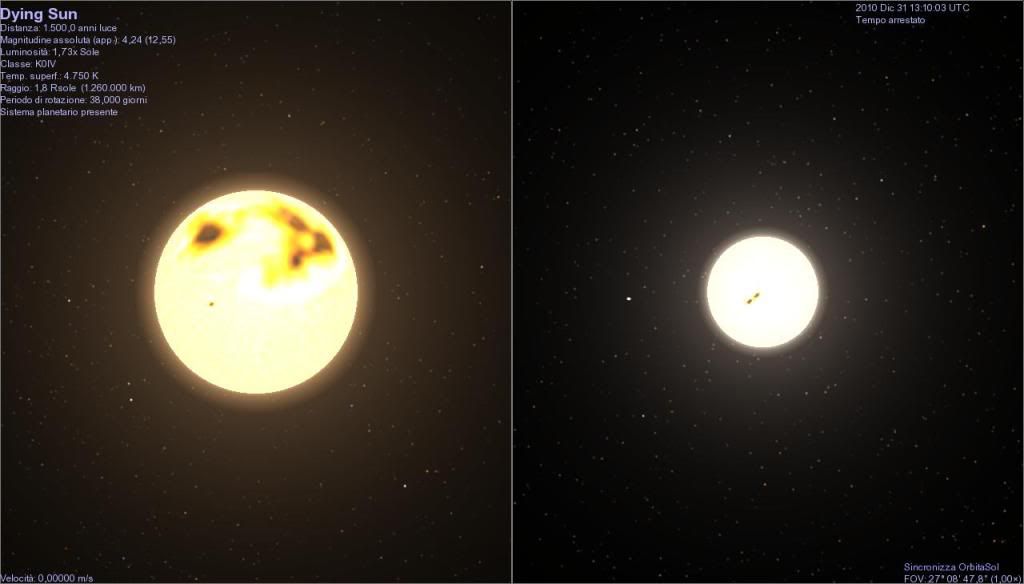
On the other hand here how other nearby stars appear (scaled by distance from Sun):
- Alpha Centauri A-B: star A is slightly older than Sun, thus it's evolving off the Main Sequence alike Sun: it is passing through subgiant stage, with spectral type G8IV and nearly three times the Sun's luminosity. Star B is less massive and will live more. But it won't be so lively due to evolving primary and increasing luminosity of its.
- Sirius: the Dog's Star is already experiencing the first phase of red giant phase (assuming as old as 300 million years), appearing as a bright giant of spectal class K0II (luminosity=700 times that of Sun, 28 times brighter than before). White dwarf companion B is appear much dimmer than before and really hard to resolve.
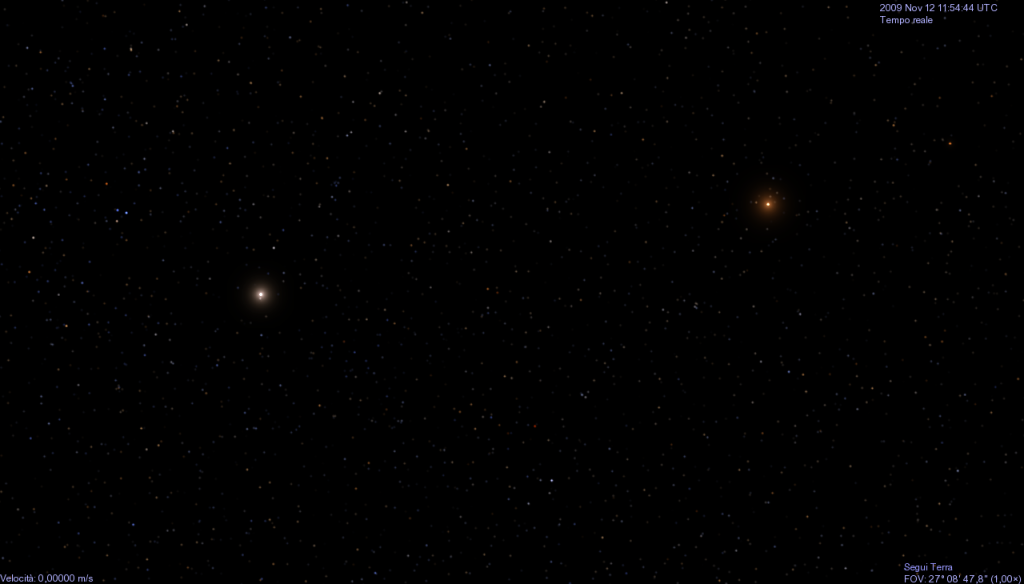
The Howling Dogs, Sirius (left) and Procyon (right).
- Procyon: much more evolved than nearby Sirius, Procyon is just through first stage of red giant star. Effective temperature significantly lowered (T=3,460 Kelvin from former 6,650) and radius enormously bloated (180 Solar radii) let the star being classified as Mira-type pulsating giant, with S6III spectral type. Luminosity nearly 4,200 higher than Sun. Moreover the star that now interacts with white dwarf companion as symbiotic binary (alike much further away stars R Aquarii, CH Cygni). People now calls Gomeisan "the Monster" this nearby crimson star.
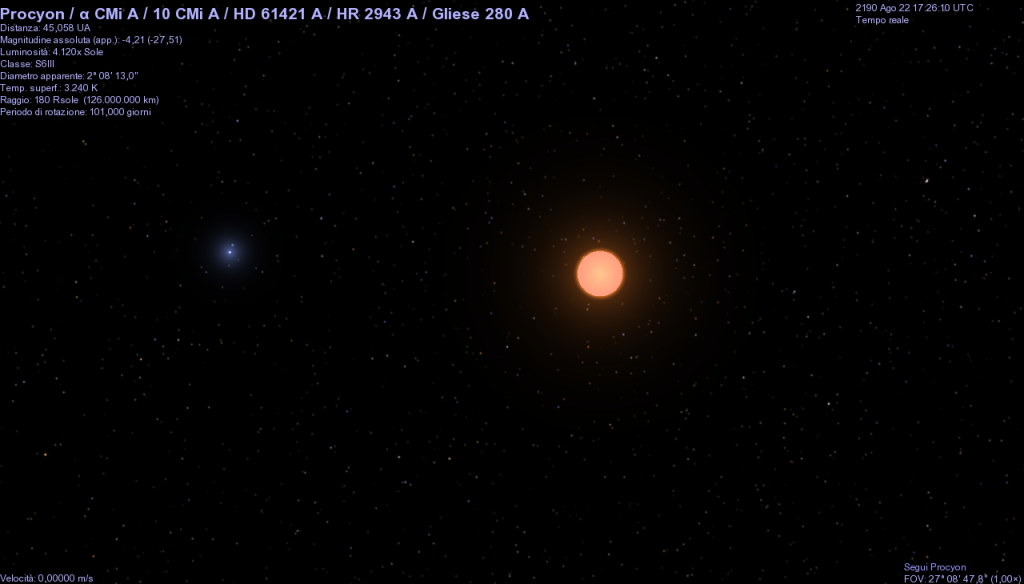
"Gomeisa Procyon" + white dwarf companion, the blue dot at Mira-type star's right.
- Tau Ceti: much older than Sun (7 billion years) it does appear as a K2III giant, with radius 15 times larger than Sun and nearly 80 times more luminous.
- Altair: the prince star of Aquila constellation (the Eagle) appears as a cold but bright K5/7III giant star. Radius 55 times larger than Sun, 700 times more luminous.
- 82 Eridani: late K4III giant 33 times more luminous than Sun.
- Delta Pavonis: passing through 1st red giant phase, the star is currently a K3III giant, 53 times more luminous than Sun.
- Gamma Pavonis: K3III giant 124 times more luminous than Sun.
- Beta Hydri: 2nd stage Red giant star of Mira-type, with likely spectral type of M7III. Close to post-AGB phase. 2,500 times more luminous than Sun.
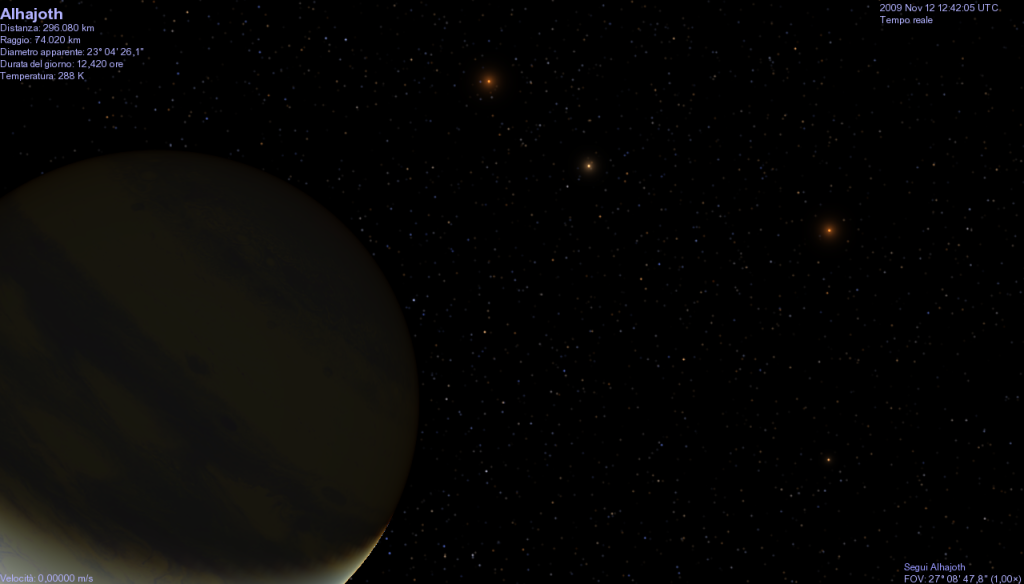
The Death's Triangle = Procyon + Sirius + Beta Hydri triangle seen from a planet orbiting Capella.
- Vega: it has evolved off the main sequence and appears alike a G0Ib pulsating Cepheid.
- Arcturus: the star lies in advanced phase of stellar death, appearing as briefly luminous post-AGB star, a hot but shrunken subdwarf star (sdB-type star) surrounded by hot gas forming a planetary nebula.
- Pollux: it appears as another post-AGB star with subsequent dim planetary nebula. Degenerate star as a hot B subdwarf (T=18,700 K). The planet has surived and lies nearly at same orbital separation (roughly 1.6 AUs)
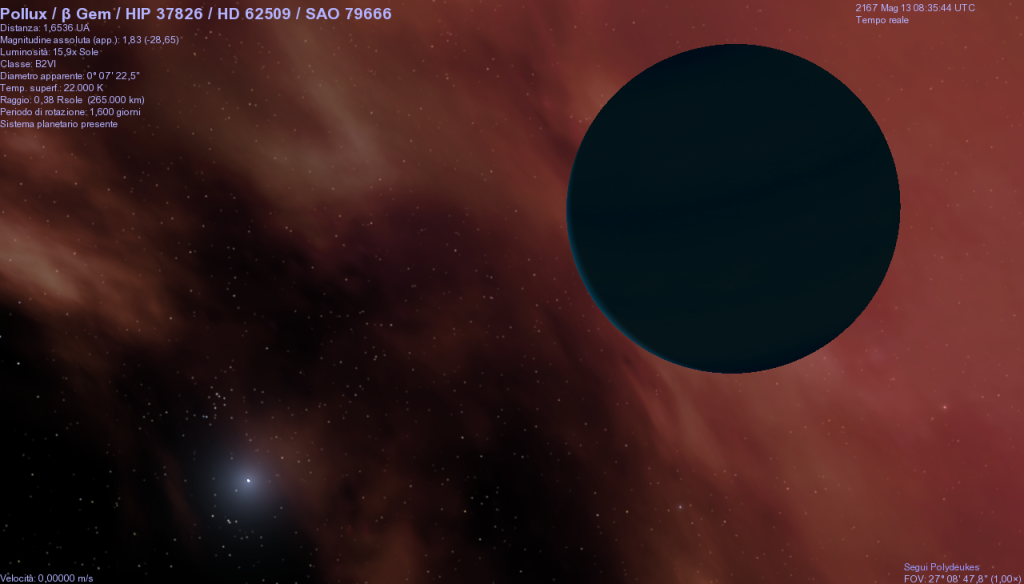
Pollux, subdwarf remnant with planetary nebula and survivor planet.
- Iota Persei: an orange K1III giant 180 times more luminous than Sun.
- Gamma Cephei: a pulsating M3III giant with dim red dwarf companion and survivor planet in torch orbit.
- Capella: a couple of white dwarfs orbiting around common orbital barycentre.
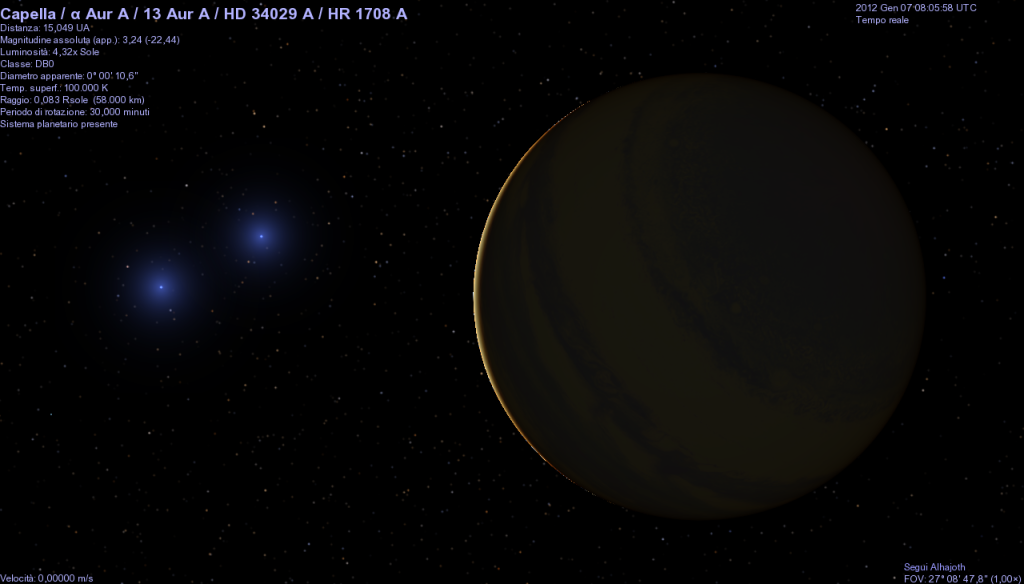
Nannygoats, Capella as seen from a hypothetical planet.
- Aldebaran: it's nicknamed "Bullwinkle" by Earthlings because of its stellar remnant, a neutron star. The closest pulsar to Solar System.
- Algol: evolving primary has "swallowed" secondary K2III-IV subgiant and interacts only with former tertiary (yet unevolved) component. Thus the Demon Star includes a F7Ib supergiant and a close-in A5-type main sequence star.
- Gacrux: another neutron star, with invisible companion, likely a white dwarf.
There would be more stars to list, but I would quit here.
Further thread bumps should display more rendering of planets and other stuff.
It was funny to imagine how notable stars will appear in the future.
I am also developing stc and ssc files for fictional evolved systems.
It would be a curious extra as Celestia Add-on.
Next session is:
[big]How does Dystopia Earth appears?[/big]
The Sun is dying but hasn't reached the red giant phase yet, but passing through lively subgiant stage. So our star appears twice more luminous than before and radius twice larger. With these conditions the habitable zone has shifted from 1 Astronomical Unit to 1.4 (nearly the Mars' orbital zone). Mars indeed has been terraformed and forms a world apart with its human population.
Earth is slowly turning into a Venus' analogue.
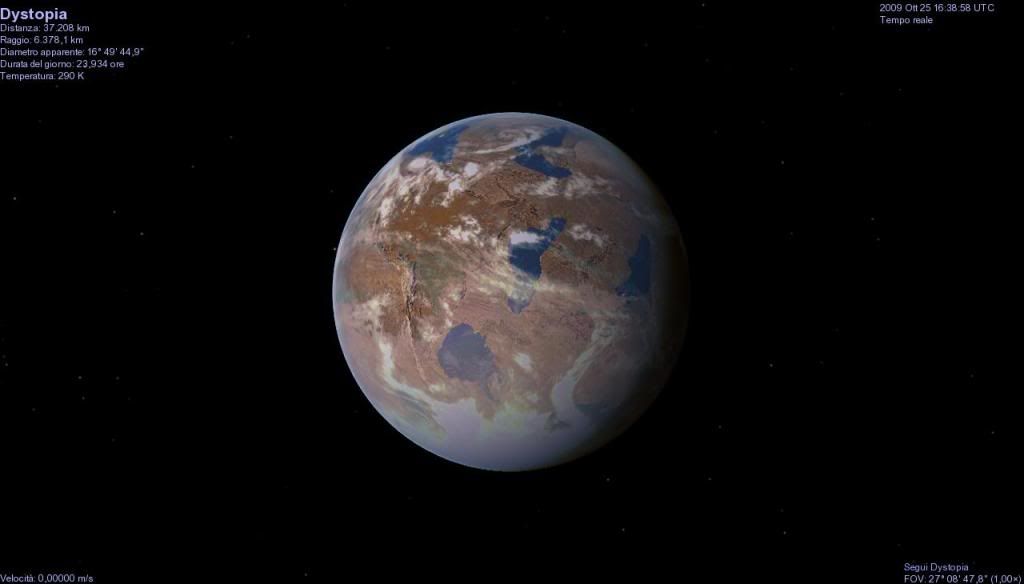
Oceans have almost gone evaporated, filling the upper stratosphere, increasing greenhouse effect. Essiccation reaches ocean floor and few abyssal trenches still host liquid water forming few sparse seas. Everything appear harsh and barren above and below ancient ocean levels. A concept map is viewable here (it is also available at deviantArt account of mine, with much better full-view resolution):
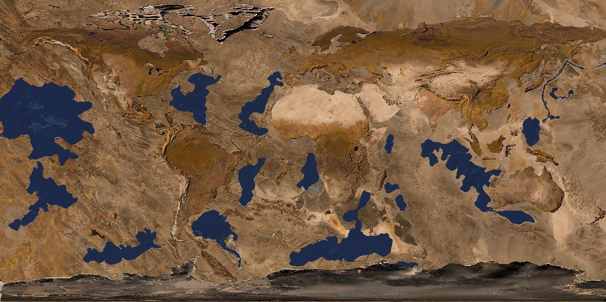
Solar evolution and a wicked management of natural resources, wars and biotechnologically-driven epidemies have caused mass extinction has erased 90% of lifeforms but new ones are developing. Notwithstanding evolution has taken million years to "create" and "select" lifeforms, infections by bizarre microrganisms are causing occurrence of new species, humans included. These microrganisms act as Wolbachia bacterium does (or better did) with certain mosquitos, but in much intrusive and mutagenic way.
[big]What's happened to Mankind?[/big]
There is another thread at another site about this. Ask me if interested.
Feedback about models' feasibility is requested.
Suggestions and critiques are welcome
What an impressively long post!!
Thanks for the attention
